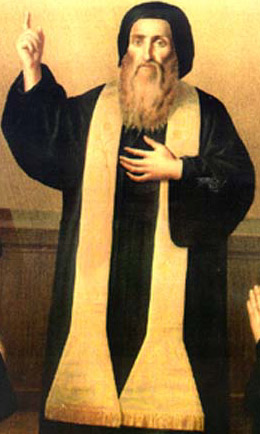
"Historia Religiosa", written by Theodoret of Cyrrhus around 440 A.D. is our only source on St. Maroun’s biography. The author describes the life of hermits in Cyrrhus and vicinity. In chapter 16 the author mentions that St. Maroun was one of those hermits. He had a tremendous influence on his disciples (22).
St. Maroun consecrated the temple for divine Christian worship. The pattern of his life had a great influence on his disciples who followed suit and were "as plants of wisdom in the region of Cyrrhus"(23). St. Maroun’s sainthood became known throughout the Empire. St. John Chrysostom sent him aletter around 405 A.D. expressing his great love and respect and asked St. Maroun to pray for him.
St. Maroun died around 410 A.D. and willed to be buried in St. Zabina’s tomb in Kita in the region of Cyrrhus. However, his will was not executed because people from different villages wanted to have him buried in their towns. Theodoret’s description of St. Maroun’s burial place<.4) points to the populous town of Barad in the proximity of Kfarnabo. A huge church was built in that town around the beginning of the fifth century A.D. (25).
Inside this church there was a sarcophagus, which possibly contained St. Maroun’s body. According to a Maronite tradition, the followers of St. Maroun carried the relics of the Saint, especially the skull, to St. Maroun’s Monastery or "Beit Maroun" built in 452 A.D. between Hama and Aleppo in Syria.
Relic of Saint
The skull was carried to St. Maroun’s Monastery in Kfarhai, Batroun – Lebanon around the turn of the eighth century. Patriarch Douaihy mentions: "When Youhanna (John) Maroun settled in Kfarhai, he built an altar and a monastery after St. Maroun’s name and put St. Maroun’s skull inside the altar to heal the faithful. That’s why the monastery is called "Rish Mro" (Syriac) meaning "Maroun’s head"(26).
Later, St. Maroun’s skull was taken to Italy. In 1130 A.D. one of the Benedictine monks came to the region. This monk was the rector of the Cross Afonastery near Foligno-Italy. During his visit he heard about St. Maroun’s skull, and upon returning home he publicized St. Maroun’s virtues. As a matter of fact, a church was built after St. Maroun’s name in Foligno. The Bishop of Foligno carried the skull to the city in 1194 A.D. and put it in the church of the diocese. The faithful in the city made a statue of silver for St. Maroun and put the skull in it. During his stay in Italy in 1887, Bishop Youssef el-Debs was given some relics of St. Maroun’s skull by the Bishop of Foligno(27).



